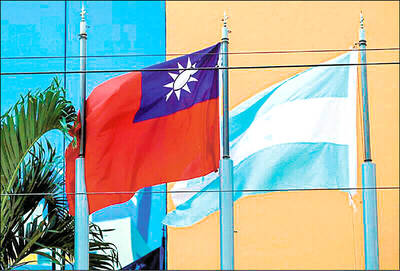The National Health Research Institutes (NHRI) yesterday said its researchers had engineered a novel vascular construct of a stem cell-laden 3D-printed scaffold that can enhance tissue revascularization.
As restoring or replacing a malfunctioning human organ is very difficult and waiting for a suitable organ for a transplant can take a long time, transplantable engineered tissue is highly sought after, but its development has been hampered by the lack of a vascular network within the engineered tissue.
The research team manufactured a novel 3D architecture scaffold with poly(glycerol sebacate) acrylate (PGSA), serving as a functional and transplantable vascular construct, which provides an innovative alternative therapeutic strategy for vascular tissue engineering, and could possibly be used to treat ischemic disease and for organ transplants.

Photo: Wu Liang-yi, Taipei Times
The research team is led by NHRI Institute of Cellular and System Medicine director Yet Shaw-fang (林秀芳) and Jane Wang (王潔), an associate professor at National Tsing Hua University’s Department of Chemistry.
To repair or regenerate ischemic tissues, revascularization is essential to support the delivery of oxygen and nutrients to the cells and to clear waste products, Jiang Wei-cheng (蔣偉程), a postdoctoral fellow at the NHRI Institute of Cellular and System Medicine, said yesterday.
One of the more recent strategies is “prevascularization,” or forming microvascular networks within the tissue construct before implantation, Jiang said.
However, a major challenge during development is insufficient cell supply in the initial stage prior to implantation, he said, adding that another challenge is selecting the biomaterial and the architecture scaffold for the development of an efficient and effective vascular construct.
Jiang said the team took a regenerative engineering approach by taking stem cells and utilizing a digital light processing system to manufacture a recently designed novel 3D-printed architecture scaffold with PGSA, to be used for the generation of novel vascular constructs.
Transplantation of the vascular construct in wounded mice resulted in the formation of a new vascular network that integrated into the existing vasculature of the host tissue, leading to revascularization and enhanced blood perfusion at the implant site, Lin said.
The technology for engineering the vascular construct could be further developed to help treat diseases, such as peripheral arterial disease in people with diabetes or another ischemic disease, she said, adding that it could also be used for organ transplants, drug testing, or in vitro tissue or organ engineering.
The team’s study was published by the journal Biofabrication in July last year, the NHRI said.

Chinese Nationalist Party (KMT) Chairman Eric Chu (朱立倫), spokeswoman Yang Chih-yu (楊智伃) and Legislator Hsieh Lung-chieh (謝龍介) would be summoned by police for questioning for leading an illegal assembly on Thursday evening last week, Minister of the Interior Liu Shyh-fang (劉世芳) said today. The three KMT officials led an assembly outside the Taipei City Prosecutors’ Office, a restricted area where public assembly is not allowed, protesting the questioning of several KMT staff and searches of KMT headquarters and offices in a recall petition forgery case. Chu, Yang and Hsieh are all suspected of contravening the Assembly and Parade Act (集會遊行法) by holding

PRAISE: Japanese visitor Takashi Kubota said the Taiwanese temple architecture images showcased in the AI Art Gallery were the most impressive displays he saw Taiwan does not have an official pavilion at the World Expo in Osaka, Japan, because of its diplomatic predicament, but the government-backed Tech World pavilion is drawing interest with its unique recreations of works by Taiwanese artists. The pavilion features an artificial intelligence (AI)-based art gallery showcasing works of famous Taiwanese artists from the Japanese colonial period using innovative technologies. Among its main simulated displays are Eastern gouache paintings by Chen Chin (陳進), Lin Yu-shan (林玉山) and Kuo Hsueh-hu (郭雪湖), who were the three young Taiwanese painters selected for the East Asian Painting exhibition in 1927. Gouache is a water-based

Taiwan would welcome the return of Honduras as a diplomatic ally if its next president decides to make such a move, Minister of Foreign Affairs Lin Chia-lung (林佳龍) said yesterday. “Of course, we would welcome Honduras if they want to restore diplomatic ties with Taiwan after their elections,” Lin said at a meeting of the legislature’s Foreign Affairs and National Defense Committee, when asked to comment on statements made by two of the three Honduran presidential candidates during the presidential campaign in the Central American country. Taiwan is paying close attention to the region as a whole in the wake of a

OFF-TARGET: More than 30,000 participants were expected to take part in the Games next month, but only 6,550 foreign and 19,400 Taiwanese athletes have registered Taipei city councilors yesterday blasted the organizers of next month’s World Masters Games over sudden timetable and venue changes, which they said have caused thousands of participants to back out of the international sporting event, among other organizational issues. They also cited visa delays and political interference by China as reasons many foreign athletes are requesting refunds for the event, to be held from May 17 to 30. Jointly organized by the Taipei and New Taipei City governments, the games have been rocked by numerous controversies since preparations began in 2020. Taipei City Councilor Lin Yen-feng (林延鳳) said yesterday that new measures by